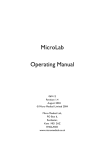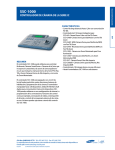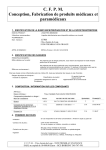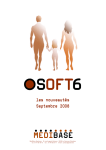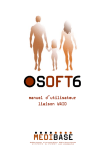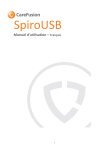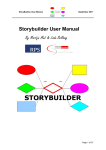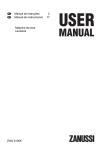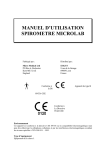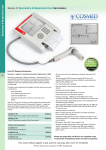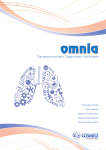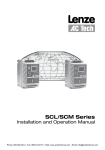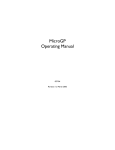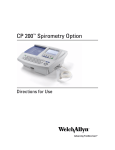Download - Frank`s Hospital Workshop
Transcript
MicroLab Operating Manual 043-04 Revision 1.4 June 1998 Micro Medical Ltd., PO Box 6, Rochester, Kent ME1 2AZ ENGLAND Windows is a trademark of the Microsoft Corporation MediBase and DiaryCard are trademarks of Micro Medical Ltd. Specification of the MicroLab Measurements: Relaxed Vital Capacity (VC) Forced Vital Capacity (FVC) Forced Expired Volume in 1 second (FEV1) FEV1 as a percentage of FVC (FEV1%) Peak Expiratory Flow Rate (PEF) Peak Inspiratory Flow Rate (PIF) Flow rate at 50% of expired volume remaining(F50) Flow rate at 25% of expired volume remaining (F25) Mid-Expiratory Flow Rate (MEF) Flow Rate at 50% of inspired volume remaining (I50) Ratio of I50 to F50 (R50) Forced expiratory time (FET) Indirect measurement of Minute Ventilation (MVV Ind) All with baseline and post bronchodilator comparison. Storage : 90 tests including Flow/Volume loops and Volume/Time curves. Printer Type: 320 dot per line thermal printer. Predicted Values: Percent Predicted reported for all values except I50, R50, PIF, MVV(Ind), and FET. Adults: E.C.C.S. (Varies with version supplied.) Children: Zapletal et al 1977 (FEV1, MEF) 1982 (FVC), Cogswell et al 1977 (PEF) Solymar et al 1980 (F50,F25). Display: Graphic LCD 128x64 dots. Transducer:Micro Medical Bi-Directional Digital Volume. Resolution: 10ml volume 0.03l/s flow Accuracy: +/-3%. (To ATS recommendations Standardisation of Spirometry 1994 update for flows and volumes) Power supply: Input 100 to 250V, 50 to 60Hz. Output 12V 1.5A (Class 1 equipment) Battery Pack: Rechargeable NiCad 7.2V 600mA hours. Dimensions: 134x274x51.5mm. Transducer 50x60x90mm. Weight: 820g, 2.3kg with carry case and accessories. Tests per subject: VC-unlimited (best reported), FVC-9. Relaxed Vital Capacity Test Forced Vital Capacity Test Report Menu Post Bronchodilator Test Report Save Test Print Test End Examination Printing Stored Records Recall Record User Customisation Uploading Results PC Utilities Software Spida PC Software MediBase PC Software Charging Procedure Battery Management Paper Loading Calibration Check Looking after the MicroLab II Servicing Cleaning the Transducer Specifications page 6 page 7 page 9 page 10 page 10 page 13 page 14 page 20 page 21 page 23 page 24 page 25 page 26 page 26 page 26 page 27 page 27 page 28 page 29 page 29 page 29 page 30 page 31 Operating Temperature: 0 to +40O C Operating Humidity: 30% to 90% RH Storage Temperature: -20 to + 70O C Storage Humidity: 10% to 90% RH Calibration Check 31 CONTENTS Introduction Package Contents Operation Patient Details Entry page 2 page 3 page 4 page 5 The MicroLab is calibrated to read in litres at body temperature, barometric pressure saturated with water vapour (BTPS) for FEV1 and FVC. The units of PEF, F50, F25, I50 and MEF will be in litres per second BTPS. The calibration should remain stable indefinitely, unless the transducer is physically damaged, and the unit should not require re-calibration. However, as a check on the correct functioning of the unit we do recommend that the calibration is checked periodically. To check the calibration of the MicroLab a large syringe should be used. This should have a 30mm outlet and be of at least three litres in capacity and preferably six litres. A 3 Litre Syringe is available from Micro Medical as Cat. No. SM2125. The MicroLab should be set up to record a FVC manoeuvre, connected to the syringe with the minimum of adapters. The syringe volume should be injected into the transducer evenly, without pausing. If, after checking, the MicroLab appears to require re-calibration then please refer to your supplier for service. Looking after your MicroLab Spirometer Please observe the following precautions: * Avoid exposing the MicroLab to direct sunlight. * Avoid operating the spirometer in dusty conditions or near to heating appliances or radiators. * Do not keep the spirometer in a damp place or expose it to extremes of temperature. * Do not direct the transducer holder towards a strong light source whilst operating the spirometer. * Check the AC charger for compatibility with local power rating. Servicing A full service manual including circuit diagrams and parts list is available on request. which measures expired air directly at B.T.P.S (Body Temperature and Pressure with Saturated water vapour) thus avoiding the inaccuracies of temperature corrections. This transducer is insensitive to the effects of condensation and temperature and avoids the need for individual calibration prior to performing a test. The MicroLab has many advanced features including a graphic display giving real time Flow/Volume or Volume/Time curves, user customisation of instrument functions, predicted values, and the ability to carry out pre and post bronchodilator testing. The MicroLab can be used to make and record up to 90 complete spirometry tests, on any number of patients, including the thirteen most common inspiratory and expiratory spirometry measurements, Flow/Volume and Volume/Time curves. The recorded tests can be printed using the integral printer or uploaded to a computer running Micro Medical spirometry software. To upload to a computer the unit is connected with the serial lead provided with both PC Utilities software and SPIDA spirometry software. SPIDA is a fully Windows™ compatible spirometry system that can interface to the spirometer in either of two ways. Firstly, tests recorded with the spirometer can be uploaded to SPIDA and appended to the integral database, for subsequent storage and analysis. Secondly, live spirometry may be performed with the instrument connected to a computer running SPIDA. In this case MicroLab becomes a powerful laboratory spirometer that can display any combination of real time Flow/Volume loop, Volume/Time curve, and child incentive animation together with powerful reporting and database facilities. The spirometry measurements, Flow/Volume loop, and flow volume curve may be printed at the time of testing or at any time subsequently from memory. 2 Charging Procedure 29 Introduction The Micro Medical MicroLab Spirometer is a compact and fully portable data recording spirometer with integral printer that can be operated directly from the mains power or from the integral rechargeable NiCad battery pack. The spirometer uses the Micro Medical Digital Volume Transducer, an extremely stable form of volume transducer, Note: Ensure that the dc plug is inserted into the Microlab before the mains supply is connected and that the mains is switched off before removing the plug. The Charging light on the keypad will be illuminated while the batteries are being charged. The batteries will take about 16 hours to become fully charged, however the instrument may be used continuously with the mains adapter connected. Note:- Use only the AC adapter supplied. Use of any other type may cause permanent damage to the Microlab or cause a fire or electrical hazard. Battery Management There are two sources of internal battery power in the MicroLab. The recorded data is stored in a battery backed memory, supplied by a Lithium power source with an expected life of at least 10 years. The microcomputer circuitry is supplied by a 7.2 volt, 220mAhour, rechargeable nickel cadmium battery pack. The voltage of the battery pack is monitored continuously and the following warning message is displayed when the battery starts to become discharged: The battery is low. Please connect the charger This warning is not given during spirometry testing as it would interrupt the display of the Flow/Volume curve. When this warning occurs, plug in the mains adapter and continue using the instrument. If the mains adapter is not plugged in, then the battery will continue to discharge until a voltage is reached which could impair the integrity of the microprocessor. At this point the unit will turn itself off. The MicroLab also has an auto turn-off, battery saving function whereby the unit will turn itself off if no keys are pressed for about 4 minutes. This function is only active with the main menu displayed. 27 Operation The MicroLab is fully discharged when shipped from the factory and must therefore be used with the AC adapter until the internal rechargeable batteries can be fully charged (See Charging Procedure). In the interests of clarity the following instructions assume that all configurable options are enabled with the ethnic correction set to ‘Fix’, printed loops set to ‘Both’, display default set to Flow/Volume and that the units for height and PEF are set to cm and L/sec respectively (See User Customisation for detailed description of all available options). Connect the transducer to the MicroLab unit using the socket located at the rear of the instrument and turn on. An introductory screen giving the software version will be displayed momentarily: MICRO MEDICAL Micro Lab English Version 3.XX The first menu is then displayed and allows selection of test type: 14:46:55 15/03/97 Main Menu --------------------1-Relaxed VC 2-Forced VC 3-Print Records 4-Review (Recall) Memory Used 0% The first line of this display gives the current time and date which may be set under the User Customisation menu. 4 Option 4 - Reminder on Exit This option can be used to remove the screen which reminds the user to save test results when using the ‘End Examination’ option from the report menu. Option 5 - Clock Functions After selecting this option the following screen will be displayed: Clock Functions --------------------1 Display Clock 2 Set Clock 3 Set Format 4 Clear Records 5 Exit The ‘sex’, ‘age’, and ‘height’ entries are used to determine the predicted values for the various measurements. The ‘race’ entry is used to evoke an ethnic correction factor which reduces the adult predicted values of volumetric measurements by 15% in the case of non-Caucasians. For non-Caucasian children the reduction is 12%. The MicroLab may also be configured to disable the ethnic correction entry or accept a percentage ethnic correction entered for each patient, see User Customisation. Relaxed Vital Capacity Test Display Clock Using this option the current time (hh:mm:ss) and date (dd/mm/yy or mm/dd/yy depending upon format selected) will be displayed. Set Clock Setting the clock will erase all stored data and any required records must be uploaded to a PC or printed before this function is used. When all the required options have been selected they are saved in the internal memory and the instrument is ready for use. Uploading Results Note:- The Microlab should only be connected to a computer that is manufactured in accordance with EN60950 1992/1993- “Safety of Information Technology including Electrical Business Equipment. The MicroLab may be connected to your PC computer to either upload test results into a text file, using the Micro Medical PC utilities software (MM), or to store the results in a patient database using the Micro Medical PC based software. In either case the spirometer is connected to the serial port on the PC, to the port on the side of the instrument using the serial cable provided. 25 Enter the age in years and press enter. The age range is 7 to 110 years depending on version. Height: Enter the height in centimetres and press enter. The height range is 110 - 250 cm depending on version. Race: Use the ‘1’ key to select Caucasian or Non Caucasian patient. Press enter to accept the required race. Age: Use ‘CANCEL’ to delete incorrect entries before pressing enter. If this test was selected then the following will be displayed: Press a key to start... 8L Insert the disposable (or clean reusable) mouthpiece into the transducer holder. Instruct the patient to breathe in until their lungs are completely full, seal their lips around the mouthpiece, and blow out at a comfortable rate until they cannot push out any more air. When the patient has sealed their lips around the mouthpiece and is ready to blow press a key to initiate the test. 6 Option 2 - System Configuration The following selections will be offered if this option is selected: Flow unit : LPM Lung age : On Enright : On Pred line : On Graph Type: Both Display : FVL Wait key : On 1-Change E-Accept with a blinking cursor under the active option. Pressing 1 will rotate the various options and pressing enter will save that selection and move the cursor to the next option. Press Del to return to the previous screen. spirometer will not take any measurement until a key is pressed allowing the patient to breathe through the transducer tidally before measurement of a forced expiration if required. Do not press a key to start the measurement until the patient is ready to immediately perform the forced expiration. The expiratory Flow/Volume curve is displayed as the patient performs the forced expiration through the transducer. At the end of the test values for FEV1, FVC and PEF are displayed, as well as the expiratory Flow/Volume curve, to allow a decision to be made to accept or reject this blow: 10L/S FEV1= 3.63 FVC= 5.43 PEF= 7.81 1-Again 2-Reject 3-Done Flow Units This option is used to change the displayed units of peak flow from litres per minute (LPM) to litres per second (LPS). 8L Lung Age The lung age interpretation displayed on the test results report may be disabled using this option. Enright The Enright interpretation may be disabled using this option. Predicted Line The dashed predicted curve and dotted baseline curve (displayed when performing a postbronchodilator test) may be configured not to appear as default using this option. However, they may be turned on in use by pressing 7 and 8 respectively. Graph Type There are four settings for this option which controls the content of a full printed report: Off - the report showing all the results but with no Flow/Volume or Volume/Time curves produced. FVL - the report will contain all the results and a Flow/Volume loop to American Thoracic Society, ATS, recommendations. 23 Instruct the patient to breathe in until their lungs are completely full, seal their lips around the mouthpiece and blow out as hard and as fast as possible until they cannot push any more air out and then breathe in fully immediately after the expiratory manoeuvre, thus completing the Flow Volume loop. The At this point pressing 7 on the keypad will toggle the predicted curve on and off. Pressing 9 will toggle between the Flow/Volume and Volume time curves: 8L FEV1= 3.63 FVC= 5.43 PEF= 7.81 1-Again 2-Reject 3-Done 6S Pressing 6 will toggle the text on and off in order to give a 8 Once the required record is found press Enter to accept and return to the report menu: Male 25 yrs 150 cm --------------------Select Option 1-Post BD 2-Report (Save) 4-Print 5-End Examination 10L/S Press a key to start... 8L From this menu it is possible to perform a post-brochodilator test, obtain a detailed on screen report of the spirometry test (see Report), or print the results. User Customisation Many of the MicroLab’s functions can be customised by the user to suit their own requirements. The defaults set by the user are stored permanently in the spirometer and will remain unchanged until customisation is repeated. To customise the MicroLab hold the enter key down, turn the unit on, and then release the enter key when the following screen is displayed: 1 2 3 4 5 UNIT SETUP Patient Config System Config Best Criteria Reminder on Exit Clock Functions The criterion for the ‘best’ can be defined by the operator, see User Customisation. The baseline test shown can be toggled on and off by pressing 8. The predicted curve and the Volume/Time curve can be displayed by pressing 7 and 9 respectively as previously described. Complete the tests as described above for the Forced Vital Capacity test. When a valid series of post bronchodilator tests is complete, press “3”. The Report Menu screen is then re-displayed. As the Post BD tests are complete the first option is no longer available. Option 2 - Report To display the results of the current patient press ‘2’ and a select option menu will be displayed: Select Option --------------------1-Use Best Blow 2-Select Blow 9 Exit 21 Option 1 - Post Bronchodilator Test To begin a Post Bronchodilator Test on the current patient, press ‘1’. The Forced Vital Capacity screen is displayed with the ‘best’ baseline test displayed as a dotted line: 10 The patient I.D, date and time of test, baseline and postbronchodilator results are shown. 2 This option allows the summary report to be printed on a particular patient. When this option is selected the user is requested to type the patient ID so that all tests for that patient can be printed. The report appears as follows: MICROLAB Test 1 3 3300 VX.XX SUMMARY REPORT Patient ID Date 102 04/06/97 102 This algorithm relates airways' obstruction and restriction to the percent predicted FEV1, FER, and FVC for the baseline test and is shown below (Fig.2). 06/07/97 Time 09:34 09:30 :---BASE/POST---: FEV1 FVC PEF 3.66 5.28 612 3.72 5.40 620 3.77 5.27 620 3.78 5.39 610 3 The tests are numbered sequentially when stored. If a particular test is required then this option can be used to print a full report of that test. When selected the user is requested to enter the test number. 4 This option allows a block of full test reports to be printed. For example the last 20 of 80 stored records may be printed. The unit will request first and last test numbers to print. 5 Full reports on all the tests performed on one patient may be printed using this option. The unit will request the patient ID and will then print all the reports that have been stored with that ID. At any time during printing pressing CANCEL will terminate the printing. It is recommended that whilst printing the batteries are on charge with the unit connected to the mains adapter as more power is required to drive the printer mechanism. STAR T C heckm anoeuv re qua lity no F gi 2 FER be olw LLN ? yes FEV abov1e LLN ? yes bo rde r lni e obs truc toi n yes m idl obs truc toi n yes m ode ra et obs truc toi n no FEV abov1e 60% o fp red ci ted? no FEV abov1e 40% o fp red ci et d? no FVC be olw LLN ? seve re obs truc toi n no nomr a l sp irom e try yes m idl res trci toi n yes m ode ra et res trci toi n yes FVC above 60% o fp red ci ted? no FVC above 50% o fp red ci et d? no seve re res trci toi n LLN = olw e r mli ito fnomr a lity 19 Pressing 1 again will display the results for MEF, I50 and R50, followed by the next screen giving PIF, MVV (ind) and FET. The final results screen gives the relaxed vital capacity. The results screens are followed by a report of ‘Lung Age’. The next screen displays an interpretation of the spirometry results according to the algorithm published by Enright et al. 12 Option 5 - End Examination Selecting this option will delete test results of the current patient and if they are not already saved the following warning will be displayed: Reminder -------Results not saved! Printing... 1 - Exit 2 - Save Press CANCEL to abort Select Option: the MicroLab will commence printing the following report: If the results are to be saved then by selecting ‘2’ the save option will automatically be evoked. Selecting ‘1’ will delete the current patient results. The main menu is again displayed: 14:46:55 15/03/97 Main Menu --------------------1-Relaxed VC 2-Forced VC 3-Print Records 4-Review (Recall) Memory Used 0% MICROLAB 3300 VX.XX FULL REPORT Patient Name:_________________________________ ID: 12345 Sex: Male Height: 188 cm Date: Age: 03/05/97 33 All Spirometry Results TEST FEV1 FVC PEF VAR 1 3.41 3.72 511 -5 BASE 2 3 3.46 3.62 3.88 3.82 517 520 -4 0 17 Option 4 - Print To print the current patient’s data select this option and the following screen will be displayed: POST 5 3.59 3.71 520 -1 4 3.66 3.76 585 0 Best Spirometry Result From this menu it is possible to test a new patient as previously described, print a report from stored data, or recall stored data prior to printing or performing a post-bronchodilator test. Time: 09:32 Race: CAUCASIAN 6 3.48 3.86 541 -4 7 3.29 3.50 517 -10 Base = 3 Post = 4 :--- Normal---: Base %Pred PostBD %Pred %Chg Min Pred Max VC 4.00 FEV1 3.62 78 3.66 79 +1 3.79 4.63 5.47 FVC 3.82 68 3.76 67 -1 4.63 5.63 6.63 PEF 520 84 585 95 +12 496 616 735 FEV1% 95 117 97 120 +2 69 81 93 F50 4.78 83 4.80 83 0 3.58 5.75 7.92 F25 2.53 94 2.43 90 -3 1.42 2.70 3.98 MEF 4.22 86 4.26 87 0 3.21 4.92 6.63 I50 7.86 8.69 +10 R50 61 55 -9 PIF 8.30 9.18 +10 MVV 136 137 +1 FET 3.61 3.40 -6 Lung Age = 59 years Interpretation: Mild Restriction 14 Symbols L L L L/M % L/S L/S L/S L/S % L/S L S Type B device In accordance with Directive 93/42/EEC 0120 Environment This instrument complies with directive EEC89/336 electromagnetic compatibility but can be affected by cellular phones and by electromagnetic interference exceeding levels specified in EN 50082-1:1992 Electrical classification Class I equipment 3 The transducer may now be immersed in warm soapy water for routine cleaning or immersed in cold sterilising solutions e.g. Alkacide (Alcohol and chloride solutions should be avoided.) After cleaning/sterilising, the transducer should be rinsed in distilled water and dried. Alkacide is available from Micro Medical in convenient 250ml containers, Cat No. SSC1000. 4 Re-assemble the mouthpiece holder. H ous ni g Tu rb ni e transduce r C u t-ou t Loca tni g p pi 30 Cleaning the Transducer The transducer requires no routine maintenance or servicing. However, if you wish to sterilise or clean the transducer it may be removed by means of the following procedure: 1 Rotating the turbine transducer anti-clockwise until the locating pip lines up with the small rectangular cut-out in the housing as shown below. 2 Gently pull the transducer away from the housing. Package Contents The MicroLab is packaged in a sturdy carrying case containing this manual and the following items (Fig.1): 1. MicroLab microcomputer unit with graphic display 2. Micro Medical Digital Volume Transducer 3. Transducer housing. 4. AC Adapter (Part No. PSU4202) Together with a mains supply lead, spida demonstration software, and disposable cardboard mouthpieces. b. Cut the leading edge of the paper so that it is parallel to the roll shaft. c. Remove the paper cover. d. Align the paper so that it is straight when it is inserted into the paper inlet. Do not insert the paper with the wrong surface facing up. e. Press the “PAPER” key to feed the paper until the leading edge of the paper passes the paper cutter. f. Replace paper cover. 1 1 2 3 4 5 6 7 8 9 0 PAPER C ANCE L CH ARG NI G ENTER M icro M ed ica l 4 3 Make sure that the specified paper (Part Number PSA1600) is used as excessive wear on the thermal print head may occur if paper from other manufacturers is used. The following precautions should be observed when storing or handling the thermal paper rolls: * Do not store paper rolls in places exposed to direct sunlight. * Do not use pastes containing organic solvents such as alcohol, esters or ketones. * Do not allow the paper to come into contact with vinyl chloride. * Do not use cellophane tape on the paper. * Do not allow printer paper to come into contact with diazo copy paper which has been processed. 2 F gi .1 3 Paper Loading The Microlab requires thermal paper (Part Number PSA1600 Pack of 5 rolls) for the printer. A warning line appears when 30cm of the paper roll remains (approximately 2 tests). A new roll should be loaded when this mark becomes visible. To load paper: a. Switch on the Microlab 3300. 28 The Main Menu displays four options: The first option of the menu allows a relaxed vital capacity measurement to be made, prior to performing a forced vital capacity manoeuvre, if required. Select the second option to perform a forced vital capacity manoeuvre without a relaxed vital capacity measurement. Stored records can be printed, either individually or in summary form, by selecting option 3 and using the serial to parallel converter Cat. No. MLA 350. Option 4 allows any stored record to be recalled and a post bronchodilator test appended, if required. The memory used indicator gives the percentage of the total memory filled with spirometry test results. The memory is usually cleared immediately after uploading or printing data with a User Customisation option. Note: when the memory used is 100% (90 records), spirometry tests may be performed but the results can not be saved. Patient Details Entry After the required test is selected the instrument invites you to enter the patient’s details, in order to calculate the predicted values, and displays the following: Enter Patient Details --------------------Sex :Male Age : Height: cm Race : 1-Change ENTER-Accept If predicted values are not required then simply press ‘Del’ when this screen first appears. If predicted values are required then enter the patient’s details as shown below: Sex: Use the ‘1’ key to select male or female patient. Press enter to accept the required sex. 5 It is recommended that whilst the unit is connected to a computer the batteries are on charge with the unit connected to the mains adapter as more power is required to drive the serial interface. PC Utilities Software The PC Utilities software contains a number of supporting utilities for use on IBM compatible PC’s running DOS or Windows. The utilities provide a simple and convenient way to initialise the instrument, set its internal clock, and to upload data from it into an ASCII text file. The Windows version also provides a facility for viewing a trend graph of the results, with a wide variety of display options and statistical functions available. The uploaded data can be imported into most database and spreadsheet programs for further analysis. Full details of the installation and use of the software are given in a separate PC Utilities manual. Spida Spida is an easy to use PC based Windows™ application that interfaces to the MicroLab via a serial port. It incorporates a database into which patient details can be entered and records from the MicroLab uploaded. Using Spida and the MicroLab, live blows can be performed with the PC directly controlling the operation of the MicroLab. The results and graphs produced are displayed directly on the PC screen. MediBase™ Medibase contains all the functionality of Spida, but allows for the customisation of the way spirometry and patient data is displayed. Medibase can also integrate with existing databases. It uses ODBC (Open DataBase Connectivity) technology to interface directly to a variety of database systems, ranging from local PC databases such as Paradox, Dbase and FoxPro, to major mainframes systems such as Oracle, Informix and DB2. MediBase can access several patient databases to easily combine clinical measurements with information from a variety of sources. Details of the installation and use of this software are given in a separate MediBase manual. NOTE: Keep the PC out of reach of the patient when connected to the MicroLab. 26 The use of a nose-clip is advised. A solid moving bar is displayed as the patient breathes through the transducer: Display The display can show the Flow/Volume (FVL) or Volume/Time (VT) graphs as default when performing a spirometry test. In either case the display can be changed after a spirometry manoeuvre by using key 9. Ready VC This VC= 2.61 Best VC= 0.00 1-Again 2-Done 8L The Relaxed Vital Capacity of this blow and the ‘best’ blow for the current patient is displayed. The test may be repeated as many times as is necessary to achieve an acceptable result. To repeat the test press ‘1’. To complete the VC test press ‘2’ and the best result will be stored. The FVC test will start automatically. Forced Vital Capacity Test This test is selected either from the first menu, or after completion of a Relaxed VC test. The spirometry screen is displayed showing the predicted Flow/Volume curve as a dashed line: 10L/S Press a key to start... 8L The predicted curve will only be displayed if the patient details have been entered. 7 VT - the report will contain all the results and a Volume/Time curve to ATS recommendations. Both - the results together with both Flow/Volume and Volume/Time curves will be printed. Wait Key When performing a test, the message ‘Press a key to start’ can be disabled. In this case a spirometry manoeuvre may be performed immediately after the patient details have been entered. Option 3 - Best Criteria Using this option the criteria for the automatic selection of the best manoeuvre of a series can be selected: 1 2 3 4 Best Criteria FEV1+FVC FEV1 FVC FEV1+FVC PEF The current selection is shown at the top of the screen and may be changed by selecting the required criteria of maximum FEV1, FVC, PEF or sum of FEV1 and FVC. The selected criterion is used to automatically select the best blow when saving, printing or reporting a series of manoeuvres. The chosen criterion is also used to select for display the best baseline result when a post-bronchodilator manoeuvre is performed. 24 clear view of the curves if required. Repeat the test as described above. The previous Flow/Volume curve will remain on the screen. The variation between the current test and the best test is displayed (Var). The measurement used to calculate this variation (FEV1, FVC, PEF, or FEV1+FVC) will depend upon the best test criterion selected with the user customisation. The total number of tests stored is nine (baseline and post bronchodilator) and therefore it is advisable to reject obviously poor or inconsistent efforts by pressing ‘2’ to reject such blows. When satisfied with the blows, press “3”. Report Menu Now that the baseline spirometry test is complete a number of options become available and can be selected from the report menu: Male 33 yrs 186 cm --------------------Select Option 1-Post BD 2-Report 3-Save 4-Print 5-End Examination Patient Details ---------------------Ask Details: On Height Units: cm Race Entry: Fix 1-Change E-Accept with a blinking cursor under the active option. Pressing 1 will rotate the various options and pressing enter will save that selection and move the cursor to the next option. Press Del to return to the previous screen. Ask Details This option will allow the patient detail's entry screen to be disabled if not required. If this is done then predicted values will not be displayed. Height Units The height data on the patient details screen may be entered in centimetres (cm) or inches (in). The current patient’s sex, age and height are displayed on the top line of the Report Menu as an aid to identification if the patient details were entered. NOTE: The baseline results may be saved, using option 3, and recalled later to perform a post-bronchodilator test if it is required to test other patients whilst waiting for the bronchodilator to take effect. 9 Option 1 - Patient Configuration When this option is selected the following will be displayed: Race Entry The ‘race’ entry is used to evoke an ethnic correction factor to the predicted values and has 3 options. The Fix option gives a fixed reduction to the adult predicted values of volumetric measurements by 15% in the case of nonCaucasians. For non-Caucasian children the reduction is 12%. The % option allows the user to type in an individual percentage reduction for the volumetric predicted values on the Patient Details screen. The Off option disables any ethnic correction and the race entry will not appear on the Patient Details screen 22 The choice is now available to use the ‘best’ blow for the report or to manually select the ‘best’ blow. If manual selection is chosen a summary of the blows is displayed showing the blow number, FEV1, PEF, and FVC for the baseline test. The ‘best’ selection is offered but can simply be typed over with the number of the required selection. After baseline selection the Post BD blows are offered for selection (if relevant). Once the selection is complete the report appears: Review Records --------------------Review from: 78 2/4 FEV1 FVC PEF Base % Pred PostBD % Pred % Chg 1-Next 1.63 2.90 5.21 79 80 87 2.12 3.51 5.90 103 97 99 +30 +21 +13 2-Prev 3-Exit and gives the following information: Line 1 The digits 2/4 refer to the tests selected for the baseline and post bronchodilator measurements respectively. This is followed by the headings for the 3 measurements FEV1, FVC, and PEF. Line 2 This gives the baseline results for the 3 measurements. Line 3 The baseline results as a percentage of the predicted values are given. Line 4 The results of the post bronchodilator test are given. Line 5 The post BD results as a percentage of the predicted values are given. Line 6 The percentage increase, or decrease, of the reported measurements after administration of the bronchodilator. Line 7 This line gives three menu options to display the next or previous screen and to exit back to the report menu. Using key 1 and 2 all the results of the test can be displayed. The next screen displayed shows the above results but for the measurements FEV1%, F50 and F25. 11 Recall Record The recall option from the main menu allows stored data to be recalled prior to printing or performing a post-bronchodilator test. When selected the following will be displayed: No. of records: 78 CANCEL to exit The last stored record is offered as a starting point for the record review. Type the required test number, if known, and press enter to display the records: Rec:70 12:29 12/04/97 ID : 1234 Sex:Male Age :25 Hgt: 150cm Race :CAU Base = 3 Enter to Recall 1:Next 2:Prev 3:Exit The display shows the record number, time and date of the test on the top line. This is followed by the patient I.D, Sex, Age, Height, and race entries. The number of baseline and postbronchodilator tests performed (if applicable) is also given. Keys 1 and 2 can be used to scroll through all the stored records. 20 The next screen shows the expiratory Flow/Volume loop with the predicted, baseline and post-bronchodilator curves shown as dashed, dotted, and solid lines respectively. This screen is followed by the same information displayed as Volume/Time curves. Option 3 - Save This option can be used to save the results for future processing by uploading to a computer, printing, or appending a post-bronchodilator test to a saved baseline result. The MicroLab saves the selected baseline or baseline with post bronchodilator test together with the respective Flow/Volume loops and Volume /Time curves. The patient details and predicted values are also stored. When this option is selected the following screen will be displayed: Save Record --------------------Patient ID [_ ] An identification number, up to 9 digits long, may now be entered. This number will be used to identify the results when the data is subsequently uploaded to the computer. It is therefore advisable to make a list relating this number to the patient's identity if the spirometer is used to record results from several subjects. Once the ID is entered the data is saved and the display returns to the report menu. 13 Print Records --------------------1 All Summary Report 2 Patient Summary 3 Single Test Report 4 Multi Range Reports 5 All Patient Reports CANCEL to exit The stored data can be printed as a summary report giving the test number and patient ID, together with baseline and post BD results for FEV1, FVC and PEF. A full report giving a further 9 spirometry measurements together with the normal values, % change for post BD test, full patient details, Enright’s interpretation, Lung Age, Flow-Volume loop and Volume/Time curve with predicted and post-bronchodilator curves is also available. The data to be printed can be selected from different sets as detailed below: 1 Selecting this option prints the summary report for all the currently stored data. A summary report appears as follows: MICROLAB Test 1 3300 VX.XX SUMMARY REPORT Patient ID Date 102 04/06/97 Time 09:34 2 230 05/06/97 10:45 3 102 06/07/97 09:30 :---BASE/POST---: FEV1 FVC PEF 3.66 5.28 612 3.72 5.40 620 4.66 6.11 751 4.71 6.15 755 3.77 5.27 620 3.78 5.39 610 The tests are numbered sequentially from the first recorded test. Printing Stored Records If the Print Records option is selected the following menu is displayed: 18 The first part of the report gives the patient details together with the date and time of the spirometry test. This is followed by the baseline and post-bronchdilator results (FEV1, FVC, and PEF) for all the recorded manoeuvres performed by the patient with the selected best tests printed in bold type. The percentage variation (VAR) of each test from the best test is also given. The best results are then printed in full with ten other measurements from the manoeuvre. The percentage of predicted value, percentage post-bronchodilator change and the normal range is also given. The results are followed by the estimated lung age and Enright’s spirometry interpretation (see Report section). These results are followed by the Flow/Volume and Volume/Time curves: Fl ow/V olum e Flow/Volume 8L BASE POST PRED VC 6 12 BASE POST PRED FEV1 10 4 8 6 2 4 2 8S 8L 2 Normal Values: ECCS (adult) Zapletal,Solymar,Cogswell (child) 4 Results at BTPS 6 Technician: ____________________________ 8 Physician: _____________________________ 15 The predicted, baseline, and post-bronchodilator curves are shown where applicable. In addition an FEV1 marker is provided on the Flow/Volume curves and the relaxed vital capacity (VC) is indicated on the Volume/Time curve.. Note: The unit may be configured to print only the Flow/Volume loop or the Volume /Time curve or neither and the printout will be reduced accordingly. 16




















